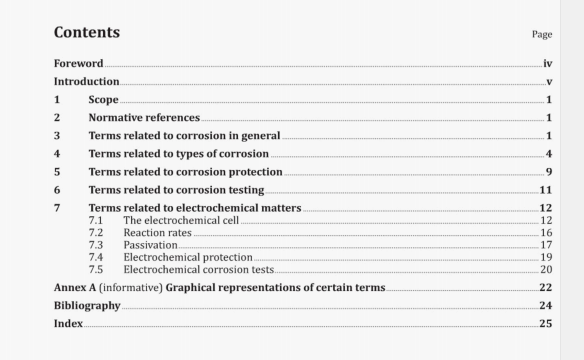ISO 8044 pdf download – Corrosion of metals and alloys -Vocabulary.
3.19
critical humidity
value of the relative humidity of an atmosphere above which there is a sharp increase in the corrosion rate (j12) of a given metal
3.20
corrosion attack
corrosion effect (15) that is detrimental but has not progressed to the point of impairment of the [unction of the metal, the environment or the technical system, of which these form a part
3.21
pickling
removal of oxides or other compounds from a metal surface by chemical or electrochemical action
3.22
pitting resistance equivalent number
PREN
indication of the resistance of stainless steels and nickel•based alloys to pitting in the presence of chlorlde•containing water
Note Ito entry: An example formula br PREN Is given by
PREN=%Cr+3,31(% Mo)+O,S(%W)I.16(%N)
Note 2 to entry: In general, the higher the PR lN the higher the resistance to pitting corrosion (415).
3.23
trap
micro structural site at which the residence time for a hydrogen atom is long compared to the residence time in an interstitial lattice site
3.24
time of wetness
period when a metallic surface is covered by adsorptive and/or liquid films of elect rolyte (ZL1) to be capable of causing atmospheric corrosion (4.4)
3.25
threshold stress
3.26
threshold stress intensity factor for stress corrosion cracking
stress intensity (actor above which stress corrosion crack propagation is sustained
Note ito entry: The threshold stress intensity (actor is a concept at linear elastic fracture mechanics (UWM) and is applicable when the plastic zone size is large compared with the microstructure. the crack Is sufficiently long,, and a high constraint to plastic deformation prevails. i.e. under plane strain predominant conditions. For growing stress corrosion cracks, LEFM is not necessarily applicable in all detail but Is adopted as a pragmatic tool that Is commonly used.
Note 2 to entry: Stress corrosion cracks may initiate at a surFace or a surface detect and grow in the ‘small crack’ regime at stress intensity factor levels below the apparent threshold stress intensity factor. Therefore. LEFM Is not applicable In the ‘small crack’ regime.
4.26
cavitation corrosion
process involving conjoint corrosion (3.1) and cavitation
Note Ito entry: avItatlon corrosion can occur. for example, in rotary pumps and on ships’ propellers.
4.27
fretting corrosion
process involving conjoint corrosion (11) and oscillatory slip between two vibrating surfaces in contact
Note Ito entry: Fretting corrosion can occur, for example, at mechanical loints In vibrating structures.
4.28
wear corrosion
process involving conjoint corrosion (31) and friction between two sliding surfaces in contact
4.29
corrosion fatigue
process involving conjoint corrosion (3.1) and alternating straining of the metal, often leading to cracking
Note I to entry: Corrosion fatigue can occur when a metal Is subjected to cyclic straining in a corrosive environment (3,3).
4.30
stress corrosion
process Involving conjoint corrosion (11) and straining olthe metal due to applied or residual stress
4.31
stress corrosion cracking
cracking due to stress corrosion (4J1i)
4.32
hydrogen embrittlement
process resulting in a decrease of the toughness or ductility of a metal due to absorption of hydrogen
Note I to entry: Hydrogen embrittlement often accompanies hydrogen formation, for example, by corrosion (11) or electrolysis, and can lead to cracking.
4.33
blistering
process resulting in a dome-shaped defect visible on the surface of an object and arising from localized loss of cohesion below the surface
Note ito entry: For example, blistering can occur on coated metal due to loss of adhesion between coating and substrate, caused by accumulation of products from IoaIEzed corrosion r4JQ). On uncoaled metal. blIstering can occur due to excessive Internal hydrogen pressure.
4.34
spalling
fragmentation and detachment of portions of the surface layer or scale (19)
4.35
tarnishing
dulling. staining or discoloration of a metal surface, due to the formation of a thin layer of corrosion products (19)
4.36
aqueous corrosion
corrosion (31) with water or a water-based solution as the corrosive environment (3.3).
ISO 8044 pdf download – Corrosion of metals and alloys -Vocabulary
